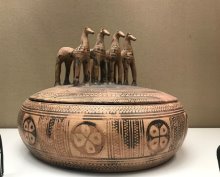
Bavani Dhinakharan and Annabel Gray (Year 11)
Last Friday, a group of 20 Latin and Classics students visited the British Museum in London to investigate ancient history in the form of red figure Greek pots, lifelike statues and ancient currency. It was highly informative and gave students, especially GCSE students, important background information and a visual aid to the content we learn in our lessons.
Miss Brice (Head of Classics) led a whistle-stop tour through the Ancient Greek vases before moving to admire a lifelike statue of Aphrodite, carved with extraordinary skill. We then carried on to the Elgin Marbles where we were invited by Miss Brice to guess which part was the most significant.
We finished our tour by searching for a list of items in one of the galleries, with the list including 'a rat playing a trumpet' and 'any interesting body parts'. The last item which Miss Brice drew our attention to was especially relevant to today's society: the tombstone of a freed slave named Regina who died at the age of 30. It was poignant as her husband, a Roman soldier from Palmyra (an ancient historical site in Syria, which has been partly destroyed in the civil war), had made the tombstone for her and written inscriptions in both Latin and his native language, Aramaic; this reminded us of Britain's varied heritage.

















.png&command_2=resize&height_2=85)



